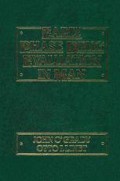Abstract
Considerable advances have been made over the past few years in the understanding of the mechanisms responsible for precipitation or exacerbating anginal pain (Maseri, 1983, 1987; Epstein et al., 1988). These advances have modified the therapeutic approach to the syndrome and it seems important to review them before presenting the methods for evaluation of anti-anginal drugs.
Preview
Unable to display preview. Download preview PDF.
References
Adam, W. E. and Stauch, M. (1985). Radionuclide methods. In Abshagen, U. (Ed.), Clinical Pharmacology of Antianginal Drugs. Springer-Verlag, Berlin, pp. 213–37
American College of Sports Medicine (1986). Guidelines for Exercise Testing and Prescription. Lea and Febiger, Philadelphia
American Heart Association. The Committee on Exercise (1972). Exercise Testing and Training of Apparently Healthy Individuals: A Handbook for Physicians. American Heart Association, Dallas
Benson, H. and McCallie, D. P. (1979). Angina pectoris and the placebo effect. New Engl. J. Med., 300, 1424–9
Boissel, J. P., Philippon, A. M., Gauthier, E., Schbath, J., Destors, J. M. and the B.I.S. Research Group (1986). Time course of long-term placebo therapy effects in angina pectoris. Eur. Heart J., 7, 1030–6
Crea, F., Margonato, A., Kaski, J. C., Roohiguey-Plaza, L., Meran, D. O., Davies, G., Chierchia, S. and Maseri, A. (1986). Variability of results during repeat exercise stress testing in patients with stable angina pectoris: role of dynamic coronary flow reserve. Am. Heart J., 112, 249–54
Demer, L., Gould, K. L. and Kirkuide, R. (1988). Assessing stenosis severity: coronary flow reserve, collateral function, quantitative coronary arteriography, positron imaging and digital substraction angiography. A review and analysis. Prog. Cardiovasc. Dis., 30, 307–22
Detrano, R. and Froelicher, V. F. (1988). Exercise testing: uses and limitations considering recent studies. Prog. Cardiovasc. Dis., 31, 173–204
Epstein, S. E., Cannon, R. O., Watson, R. M., Leon, M. B., Bonow, R. O. and Rosing, D. R. (1985). Dynamic coronary obstruction as a cause of angina pectoris: implications regarding therapy. Am. J. Cardiol., 55, 61B–68B
Epstein, S. E., Quyyumi, A. A. and Bonow, R. O. (1988). Myocardial ischaemia—silent or symptomatic. New Engl. J. Med., 318, 1038–43
Froelicher, V. F. (1984). Exercise Testing and Training. Year Book Medical Publishers, Chicago, pp. 1–23, 38–74
Glasser, S. P., Clark, P. I., Lipicky, R. J. and Yusuf, S. (1988). What is the risk of exposing patients with chronic stable exertional angina to placebo in controlled trials of new drugs? Circulation, 78 (Suppl. II), II-99 (abstract)
Iskandrian, A. S. and Hakki, A. M. (1985). Thallium-201 myocardial scintigraphy. Am. Heart J., 109, 113–28
Kaul, S., Finkelstein, D. M., Homma, S., Leavitt, M., Okada, R. D. and Boucher, C. A. (1988). Superiority of quantitative exercise thallium-201 variables in determining long-term prognosis in ambulatory patients with chest pain: a comparison with cardiac catheterization. J. Am. Coll. Cardiol., 12, 25–34
Khurmi, N. S., Bowles, M. J., Kohli, R. S. and Raftery, E. B. (1986). Does placebo improve indexes of effort-induced myocardial ischemia? An objective study in 150 patients with chronic stable angina pectoris. Am. J. Cardiol., 57, 907–11
Klocke, F. J., Ellis, A. K. and Canty, J. M. (1987). Interpretation of changes in coronary flow that accompany pharmacologic interventions. Circulation, 75 (Suppl. V), V34–V38
Kraupp, O. (1985). Pharmacodynamic principles of action of antianginal drugs. In Abshagen, U. (Ed.), Clinical Pharmacology of Antianginal Drugs. Springer-Verlag, Berlin, pp. 97–115
Marcus, M. L., Wilson, R. F. and White, C. W. (1987). Methods of measurement of myocardial blood flow in patients: a critical review. Circulation, 76, 245–53
Markham, R. V., Winniford, M. D., Firth, B. G., Nicod, P., Dehmen, G. J., Lewis, S. E. and Hillis, L. D. (1983). Symptomatic, electrocardiographic, metabolic, and hemodynamic alterations during pacing-induced myocardial ischemia. Am. J. Cardiol., 51, 1589–94
Maseri, A. (1983). The changing face of angina pectoris: practical implications. Lancet, 1, 746–9
Maseri, A. (1987). Role of coronary artery spasm in symptomatic and silent myocardial ischemia. J. Am. Coll. Cardiol., 9, 249–62
Nestico, P. F., Hakki, A. H. and Iskadrian, A. S. (1985). Effects of cardiac medications on ventricular performance: emphasis on evaluation with radionuclide angiography. Am. Heart J., 109, 1070–84
Nienaber, C. and Bleifeld, W. (1985). Assessment of coronary artery disease and myocardial ischemia by invasive methods. In Abshagen, U. (Ed.), Clinical Pharmacology of Antianginal Drugs. Springer-Verlag, Berlin, pp. 239–84
Parisi, A. F., Strauss, W. E., McIntyre, K. M. and Sasahara, A. A. (1982). Considerations in evaluating new antianginal drugs. Circulation, 65 (Suppl. I), 138–142
Reiber, J. H. C., Serruys, P. W., Kooijman, C. J., Wijns, W., Slager, C. J., Gerbrands, J. J., Schnurbiers, J. C. H., Den Boer, A. and Hugenholtz, P. G. (1985). Assessment of short, medium and long term variations in arterial dimensions from computer-assisted qualification of coronary cineangiograms. Circulation, 71, 280–8
Schaper, W., Schaper, J. and Hoffmeister, H. M. (1985). Pathophysiology of coronary circulation and of acute coronary insufficiency. In Abshagen, U. (Ed.), Clinical Pharmacology of Antianginal Drugs. Springer-Verlag, Berlin, pp. 47–96
WHO (1984). Guidelines for the Clinical Investigation of Antianginal Drugs. Geneva
Author information
Authors and Affiliations
Editor information
Editors and Affiliations
Copyright information
© 1990 The editors and contributors
About this chapter
Cite this chapter
Roland, E. (1990). Anti-anginal Drugs. In: O’Grady, J., Linet, O.I. (eds) Early Phase Drug Evaluation in Man. Palgrave, London. https://doi.org/10.1007/978-1-349-10705-6_22
Download citation
DOI: https://doi.org/10.1007/978-1-349-10705-6_22
Publisher Name: Palgrave, London
Print ISBN: 978-1-349-10707-0
Online ISBN: 978-1-349-10705-6
eBook Packages: EngineeringEngineering (R0)

